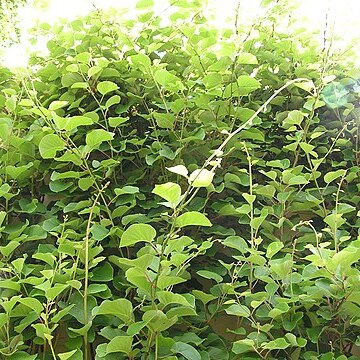Climbing shrubs, large, deciduous. Branchlets reddish, with paler oblong lenticels, young branchlets white pubescent to brownish long strigose or densely ferruginous hispid-setose; pith whitish to brown, large, lamellate. Petiole 3-6(-10) cm, white pubescent or brownish long strigose to densely ferruginous hispid-setose; leaf blade abaxially pale green, adaxially dark green, broadly ovate to broadly obovate or suborbicular, 6-17 × 7-15 cm, papery, abaxially whitish or brownish stellate tomentose, adaxially usually glabrous, occasionally ± puberulent, especially more densely so on midvein and lateral veins, or densely scabrid-hispid throughout, midvein and lateral veins conspicuous abaxially, subconspicuous adaxially, lateral veins 5-8 pairs, furcate above middle, veinlets in parallel cross-bars, conspicuous abaxially, base rounded to truncate to cordatulate, margin setose-serrulate with teeth terminating tips of veinlets, apex truncate to emarginate to abruptly cuspidate or shortly acuminate. Inflorescences cymose, 1-3-flowered, white silky-tomentose or yellowish brown velutinous; peduncles 0.7-1.5 cm; pedicels 0.9-1.5 cm; bracts linear, ca. 1 mm. Flowers orange-yellow. Sepals (3-)5(-7), broadly ovate to oblong-ovate, 6-10 mm, both surfaces densely yellowish tomentose. Petals (3-)5(-8), rarely with a second whorl of 2 smaller petals, broadly obovate, 1-2 cm, shortly clawed at base, rounded at apex. Filaments 5-10 mm; anthers yellow, oblong, 1.5-2 mm, sagittate at base or not, apex acute to rounded. Ovary globose, ca. 5 mm in diam., densely golden villous. Fruit subglobose to cylindric to obovoid or ellipsoidal, 4-6 cm, densely tomentose when young, glabrous when mature to densely hispid, with many brownish lenticels; persistent sepals reflexed. Fl. Apr-May, fr. Sep. 2n = 58*, 116*, 174*.
More
A hardy climbing shrub that loses all its leaves at one time. It climbs up to 10 m by twining around its support. The leaves are heart shaped and up to 20 cm long. Male and female flowers are on separate plants. The flowers have a sweet scent. The fruit is up to 8 cm long and 3 cm across and mostly covered with fine hairs. The inside flesh is green. This plant is the parent of Kiwifruit which are now listed as Actinidia deliciosa. The smooth skinned kind is now kept as Actinidia chinensis and the hairy one as Actinidia deliciosa.
For detailed description see Li et al. (2007); for variety occurring in Australia see Flora profile for Actinidia chinensis var. deliciosa (A.Chev.) A.Chev.: https://profiles.ala.org.au/opus/foa/profile/Actinidia%20chinensis%20var.%20deliciosa

